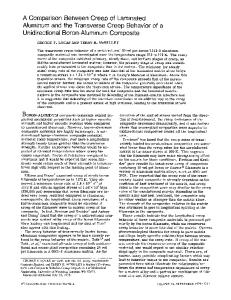Effect of a solid solution on the steady-state creep behavior of an aluminum matrix composite
- PDF / 1,359,923 Bytes
- 12 Pages / 597.28 x 777.28 pts Page_size
- 53 Downloads / 349 Views
I.
INTRODUCTION
DURING the last decade, metal-matrix composites have emerged as an important class of advanced materials owing to their attractive properties, such as higher specific modulus and higher specific strength.t~-5] Aluminum-matrix composites are now being considered for high-temperature applications. Therefore, an understanding of the creep mechanisms of these materials is important. Although a number of studies have been reported on the creep behavior of discontinuous A1-SiC composites,t6-22J the steady-state creep mechanism is not properly understood. However, one common feature of all the studies on the creep of aluminum-matrix composites is that the apparent stress exponent, n -~ 20, and apparent activation energy, Qapp = 400 kJ mol -~, for the steady-state creep are very high. These values are inconsistent with the existing theoretical or phenomenological models for dislocation creep. Recently, we have reported studies on the creep behavior of AI-SiCp (p for particulates) composites with different particle sizes and volume fractions,[~5] where the emphasis was put on the understanding of the role of dispersion parameters on the steady-state creep mechanisms. Since the major part of the creep strength of the composites is usually derived from the matrix, it is important to investigate the influence of alloying addition on the steady-state creep behavior of the A1-SiCp composite. Although it is well known that the presence of Mg as an alloying element can improve the creep resistance of aluminum significantly by retarding
A.B. PANDEY, Scientist, and Y.R. MAHAJAN, Senior Scientist, are with the Defence Metallurgical Research Laboratory, Hyderabad 500 258, India. R.S. MISHRA, Research Associate, is with the Department of Chemical Engineering and Materials Science, University of California, Davis, CA 95616. Manuscript submitted March 21, 1995. METALLURGICALAND MATERIALSTRANSACTIONS A
the movement of dislocations, studies on the influence of Mg on the creep behavior of A1-SiC composite are limited. In most of the reported studies, the 2124 A1-SiC or 6061 A1-SiC composite has been considered for investigation of the steady-state creep mechanisms. In the 2124 AI alloy composite, it is difficult to isolate the effect of alloying elements (Cu, Mg, etc.) on the creep behavior. While the 6061 AI alloy behaves like a class I solid solution for the viscous-drag-controlled creep mechanism,t23.24] similar to the AI-Mg alloy (a transition from class I to II solid solution is expected with a decrease in applied stress), an understanding of the operative creep mechanisms in the 6061 A1SiC composite is not clear. Nieh t71has reported an extensive data set on 6061 A1-SiCp, w (w for whiskers) composites with very high values of the stress exponent, n -~ 21, and activation energy, Q = 390 kJ mol -~, but has not given any explanation for the same. On the other hand, Morimoto et al. t~~ have offered an explanation for the strong stress dependence of the creep rate observed in their study on the 6061 A1-SiCw composite in
Data Loading...











